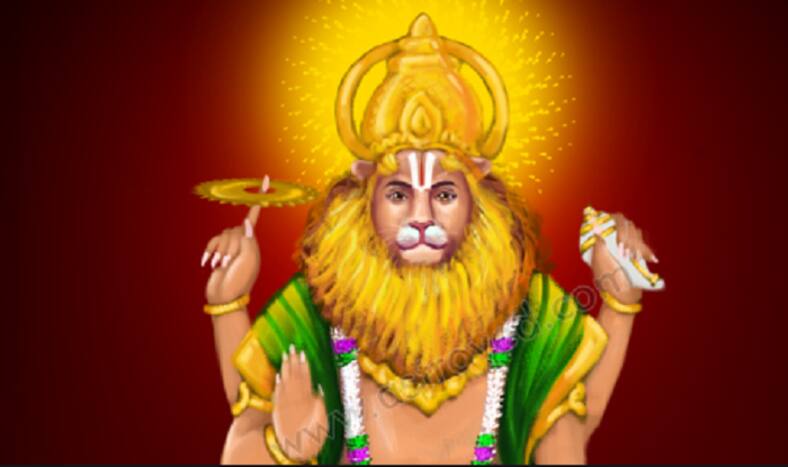Normally, we visualize gods and goddesses as pleasant-looking, serene, and exuding grace and benevolence. But in Hinduism, it is common for divinities to have fierce and blood-curdling forms, too. Such forms or avatars are taken for a purpose – to destroy evil. Thus, Lord Vishnu incarnated as Narasimha (half-man, half-lion), Lord Shiva as Rudra, and Goddess Parvati as Durga or Kali. The word ‘Nara’ means ‘man’ and ‘Simha’ means ‘lion’. Other names for Narasimha are Narsingh, Narasinghar, Narasimba, Nrisimha, Nrisingha, Narasingha, Agnilochana, Bhairavadambara, etc.
Lord Narasimha is one of Vishnu’s most popular avatars. Devotees worship him for protection from enemies and negative energies, as he is a fierce form who can strike fear into the hearts of evildoers and destroy them completely. He is the 4th avatar of Lord Vishnu.
Legend of Narasimha Avatar
The Bhagavata Purana narrates the story of Lord Narasimha. Sage Kashyapa and his wife, Diti, had two sons – the demons, Hiranyaksha and Hiranyakashipu. Vishnu’s 3rd avatar, Varaha (boar form), killed Hiranyaksha to protect the earth and humanity. This angered his brother, Hiranyakashipu, who developed an unalloyed hatred for Vishnu. After doing penance for many years to Lord Brahma, he obtained a special boon. As per the boon, he could not be killed by any weapon or human, demigod, demon, animal, or living or non-living entity created by Brahma. He could not be destroyed inside or outside any residence, during the day or night, on the ground or in the sky, either. Thanks to this extraordinary boon, he became invincible and began to rule the 3 worlds.
Prahlad was the son of Hiranyakashipu. But the young lad was a great devotee of Vishnu, unlike his father. The demon made many attempts to persuade his son not to worship Vishnu, but they failed. Finally, he decided to kill Prahlad. But here, too, he failed several times, as the boy had Vishnu’s protection. One day, in frustration and anger, Hiranyakashipu smote a pillar with his weapon and asked him where Vishnu was, since the boy said that Vishnu was present everywhere.
Suddenly, the pillar split into two, and a fearsome being emerged from it. It was Vishnu as Narasimha, half-man and half-lion. He then proceeded to lay the demon on his lap (neither on the ground nor in the sky) and disemboweled him with his fingernails (neither animate nor inanimate) on the threshold ((neither inside nor outside the house) of the demon’s palace, during the twilight hour (neither day nor night). In this manner, Hiranyakashipu met his death, despite the powerful boon he had received from Brahma.
Narasimha Jayanthi
Narasimha Jayanthi celebrates the advent of Lord Narasimha and is an important festival in India. The festival is on the fourteenth day of Shukla Paksha (waxing lunar phase) in the month of Vaishakha (April-May). People celebrate this auspicious festival to get rid of negative energies and lead a righteous life.
Narasimha Jayanti Rituals
On this day, people rise early and bathe in a holy river like the Ganga, Saraswati, or Yamuna. They may also take a dip in a nearby river or at home while chanting Vishnu and Ganga mantras. Then they do Pooja for Lord Narasimha with coconut, flowers, fruits, Chandan, saffron, incense sticks, and diyas. After chanting Slokas and Mantras for the deity, they offer Aarti. Since mythology says that Narasimha appeared at twilight, devotees who observe a day-long fast break the fast in the evening.
Lord Narasimha took birth to establish Dharma and ensure that good triumphed over evil. Hence, Narasimha Jayanthi is an occasion to reflect on our own lives and correct our mistakes so that we shun evil deeds and lead righteous lives. By doing so, we can always receive Narasimha’s protection and blessings.
Narasimha Jayanti falls on May 14, 2022, a Saturday.


